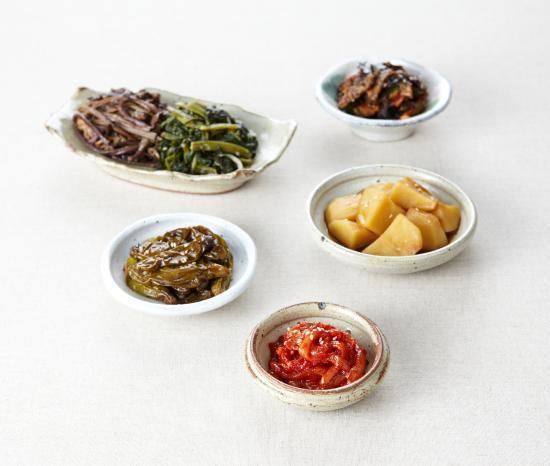Hangul 반찬 Revised Romanization banchan | Hanja 飯饌 McCune–Reischauer panch'an | |
 | ||
Banchan (Hangul: 반찬; Hanja: 飯饌; lit. "rice/food+sidedish"; /ˈbɑːntʃɑːn/; also spelled panch'an) refers to small dishes of food served along with cooked rice in Korean cuisine. This word is used both in the singular and plural. The basic table setting for a meal called bansang (반상) usually consists of bap (밥, cooked rice), guk or tang (soup), gochujang or ganjang, jjigae, and kimchi. According to the number of banchan added, the table setting is called 3 cheop (삼첩), 5 cheop (오첩), 7 cheop (칠첩), 9 cheop (구첩), 12 cheop (십이첩) bansang, with the 12 cheop used in Korean royal cuisine.
Contents
Banchan are set in the middle of the table to be shared. At the center of the table is the secondary main course, such as galbi or bulgogi, and a shared pot of jjigae. Bowls of cooked rice and guk (soup) are set individually. Banchan are served in small portions, meant to be finished at each meal and are replenished during the meal if not enough. Usually, the more formal the meals are, the more banchan there will be. Jeolla province is particularly famous for serving many different varieties of banchan in a single meal.
History
Banchan is thought to be a result of Buddhist influence at around the mid-Three Kingdoms period and the subsequent proscription against eating meat by the monarchies of these kingdoms. Thus, with the ban on meat-containing dishes, vegetable-based dishes rose in prominence and became the centrepoint of Korean cuisine; court kitchens developed various methods for cooking, preparing and presenting these dishes, while less-affluent commoners produced smaller, simpler arrays of these vegetable-based dishes.
Although the Mongol invasions of Korea ended the ban on meat-containing dishes, as well as meat offerings for rituals such as jesa, approximately six centuries of vegetable-based cuisine in the form of banchan had imprinted itself into Korean cuisine.
Kimchi
Kimchi is fermented vegetables, usually baechu (Napa cabbage), seasoned with chili peppers and salt. This is the essential banchan of a standard Korean meal. Some Koreans do not consider a meal complete without kimchi. Kimchi can be made with other vegetables as well, including scallions, gat (갓), and radish (무; mu).
Namul
Namul (나물) refers to steamed, marinated, or stir-fried vegetables usually seasoned with sesame oil, salt, vinegar, minced garlic, chopped green onions, dried chili peppers, and soy sauce.
Bokkeum
Bokkeum (볶음) is a dish stir-fried with sauce.
Jorim
Jorim is a dish simmered in a seasoned broth.
Jjim
Jjim is a steamed dish.
Jeon
Jeon denotes a variety of pan-fried, pancake-like dishes. Buchimgae is a near synonym.
